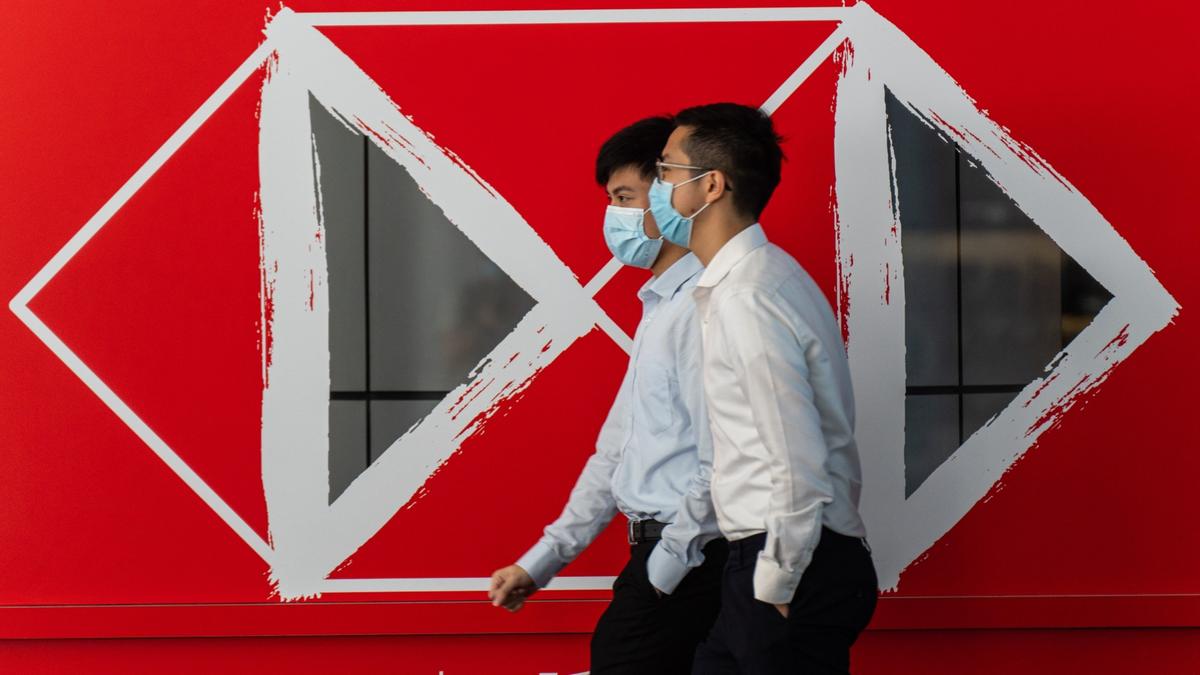 People wearing protective masks walk past a HSBC Holdings Plc logo at the bank's headquarters building in Hong Kong, China, on Thursday, Oct 22, 2020. (CHAN LONG HEI / BLOOMBERG)
People wearing protective masks walk past a HSBC Holdings Plc logo at the bank's headquarters building in Hong Kong, China, on Thursday, Oct 22, 2020. (CHAN LONG HEI / BLOOMBERG)
Global banking giant HSBC Holdings announced an interim dividend of US$0.15 per ordinary share for 2020, to be paid in cash with no scrip alternative, after the bank reported a 45 percent plunge in adjusted profit before tax to US$12.1 billion in the period.
The bank’s share price has soared more than 5 percent in intraday session as the dividend payment resumption sparked investor optimism toward the lender’s business prospects. However, the bank lost nearly all the gains to edge just 0.43 percent higher at HK$46.7 (US$5.98) per share in Hong Kong trading on Tuesday.
In response to a request from the United Kingdom’s Prudential Regulation Authority, HSBC Holdings in April last year announced it would cancel the fourth interim dividend for 2019. In addition, the bank would not make any quarterly or interim dividend payments or accruals in respect of ordinary shares until the end of 2020.
The lender said it will transit toward a target payout ratio of between 40 percent and 55 percent of reported earnings per ordinary share (EPS) from 2022 onward, in a bid to provide sustainable dividends going forward.
“In 2020, we experienced economic and social upheaval on a scale unseen in living memory. Even before the year began, the external environment was being reshaped by a range of factors – including the impact of trade tensions between the US and China, Brexit, low interest rates and rapid technological development. The spread of the Covid-19 virus made that environment all the more complex and challenging,” HSBC Holdings Group Chairman Mark Tucker said in the statement.
The bank’s share price has soared more than 5 percent in intraday session as the dividend payment resumption sparked investor optimism toward the lender’s business prospects. However, the bank lost nearly all the gains to edge just 0.43 percent higher at HK$46.7 (US$5.98) per share in Hong Kong trading on Tuesday
ALSO READ: HSBC's top executives 'prepare moves to Asia'
Reported profit before tax was US$8.8 billion, a fall of 34 percent from higher expected credit losses and other credit impairment charges and lower revenue, partly offset by a fall in operating expenses.
Net interest margin was 1.32 percent in 2020, down 26 basis points from 2019, due to the impact of lower global interest rates.
“We intend to increase our focus on areas where we are strongest, increase and accelerate our investments, and continue to progress with the transformation of our underperforming businesses. As part of our climate ambitions, we have also set out our plans to capture the opportunities presented by the transition to a low-carbon economy,” HSBC Holdings Group Chief Executive Noel Quinn noted.
The UK-based bank will continue to target an adjusted cost base of US$31 billion or less in 2022, reflecting a further reduction in the cost base, which has been broadly offset by the adverse impact of foreign currency translation due to the weakening US dollar toward the end of 2020.
Europe’s largest bank is shifting billions of dollars to beef up operations across Asia, seeking to become a market leader in wealth management by targeting a rapidly expanding affluent population in the region.
ALSO READ: HSBC revives plan to cut 35,000 jobs to boost growth
The bank outlined plans to invest about US$6 billion in Asia, targeting wealth, commercial banking and markets to drive “double-digit growth in profit.” It singled out markets in southeast Asia such as Singapore, as well as the Chinese mainland and the Hong Kong Special Administrative Region.
In addition, HSBC Holdings will continue to target a gross risk-weighted assets reduction of over US$100 billion by the end of 2022.
The lender no longer expects to reach the return on average tangible equity (RoTE) target of between 10 percent and 12 percent in 2022 as originally planned, and will now target a RoTE of greater than or equal to 10 percent in the medium term.
Common equity tier 1 (CET1) ratio was 15.9 percent, up 1.2 percentage points from 14.7 percent on Dec 31, 2019. The bank said it intends to maintain a CET1 ratio in the range of 14 percent to 14.5 percent in the medium term and managing this range down in the longer term.
Meanwhile, the profit before tax of Hang Seng Bank – the subsidiary of HSBC Holdings – dove 33 percent to HK$19.41 billion in 2020. The bank declared a fourth interim dividend of HK$2.8 per share, bringing the total distribution for 2020 to HK$5.5 per share, a plunge of 33 percent from a year ago.
READ MORE: HSBC's Asia bankers do better than peers after bonus pool cut
Hang Seng Bank’s share price slipped almost 0.2 percent to close at HK$152.5 apiece on Tuesday.
“Further growth is potentially within view with the continuation of supportive government policy initiatives and the improvement in financial markets resulting from monetary easing by the US Federal Reserve. The situation remains fragile, however, with much depending on external variables and it may be some time before economic activity returns to its pre-recession level,” Hang Seng Bank Chairman Raymond Ch’ien cautioned in the annual report.
Louisa Cheang, the bank’s vice-chairman and chief executive, added: “The consequences of Covid-19 are still playing out. Financial markets have shown some signs of improvement since the second half of 2020, but uncertainties continue to weigh on the real economy around the world. It could still be some time before we see economic recovery and a gradual return to pre-pandemic levels of business and consumer activities. The low interest rate environment will continue to put pressure on the net interest margin, which will also provide challenges for us.”
With Bloomberg inputs


